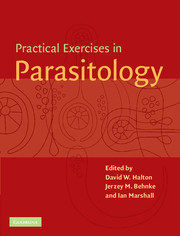Book contents
- Frontmatter
- Contents
- List of contributors
- Preface
- General advice
- 1 Observational Exercises on Parasites
- 2 Ecology
- 3 Physiology and Biochemistry
- 4 Pathology and Immunology
- 5 Chemotherapy
- 6 Molecular Parasitology
- 6.1 Purification of DNA
- 6.2 DNA digestion and gel electrophoresis
- 6.3 Restriction enzyme mapping
- 6.4 Construction of a genomic library
- 6.5 Detection and differentiation of Entamoeba histolytica and E. dispar by PCR
- 6.6 Differentiation between parasite species by agglutination and detection of parasite surface carbohydrates, using non-conjugated lectins
- 6.7 Tentative identification of parasite and tissue surface carbohydrates by conjugated lectins
- 7 Behaviour
- Appendix 1 Reagent index
- Appendix 2 UK suppliers
- Appendix 3 US suppliers
- Index
6.5 - Detection and differentiation of Entamoeba histolytica and E. dispar by PCR
Published online by Cambridge University Press: 05 June 2012
- Frontmatter
- Contents
- List of contributors
- Preface
- General advice
- 1 Observational Exercises on Parasites
- 2 Ecology
- 3 Physiology and Biochemistry
- 4 Pathology and Immunology
- 5 Chemotherapy
- 6 Molecular Parasitology
- 6.1 Purification of DNA
- 6.2 DNA digestion and gel electrophoresis
- 6.3 Restriction enzyme mapping
- 6.4 Construction of a genomic library
- 6.5 Detection and differentiation of Entamoeba histolytica and E. dispar by PCR
- 6.6 Differentiation between parasite species by agglutination and detection of parasite surface carbohydrates, using non-conjugated lectins
- 6.7 Tentative identification of parasite and tissue surface carbohydrates by conjugated lectins
- 7 Behaviour
- Appendix 1 Reagent index
- Appendix 2 UK suppliers
- Appendix 3 US suppliers
- Index
Summary
Aims and objectives
This exercise aims to:
Differentiate Entamoeba histolytica from E. dispar.
Introduce students to PCR.
Introduction
Diagnosis of infectious diseases by the detection of nucleic acids specific for the infectious agent may offer considerable advantages over traditional laboratory diagnostic methods such as microscopy and culture. One such area where this may prove very useful is in the detection and differentiation of the two morphologically similar human parasitic amoebae, E. histolytica and E. dispar. Recent work has shown that E. histolytica, the causative organism of amoebic dysentery in humans, is in fact two separate species. Prior to this work it was thought that E. histolytica generally existed in humans without disease and, in about 10% of cases, gave rise to clinical disease. It has now been shown using a combination of methods (isoenzymes, biochemical, immunological and molecular) that infection with E. histolytica, sensu stricto, is likely to lead to disease whilst infection with E. dispar results in no symptoms.
The problem in trying to diagnose which of these two organisms is present in a patient is that both organisms are morphologically identical, both in the trophozoite stage and in the cystic form. This PCR (polymerase chain reaction) method uses two pairs of discrete primers that are able to recognise and differentiate the two species. PCR provides differential diagnosis of DNA extracted from faeces. The result is detected colorimetrically in a microtitre plate, which is simpler and safer than using radio-labelled probes.
- Type
- Chapter
- Information
- Practical Exercises in Parasitology , pp. 365 - 374Publisher: Cambridge University PressPrint publication year: 2001



